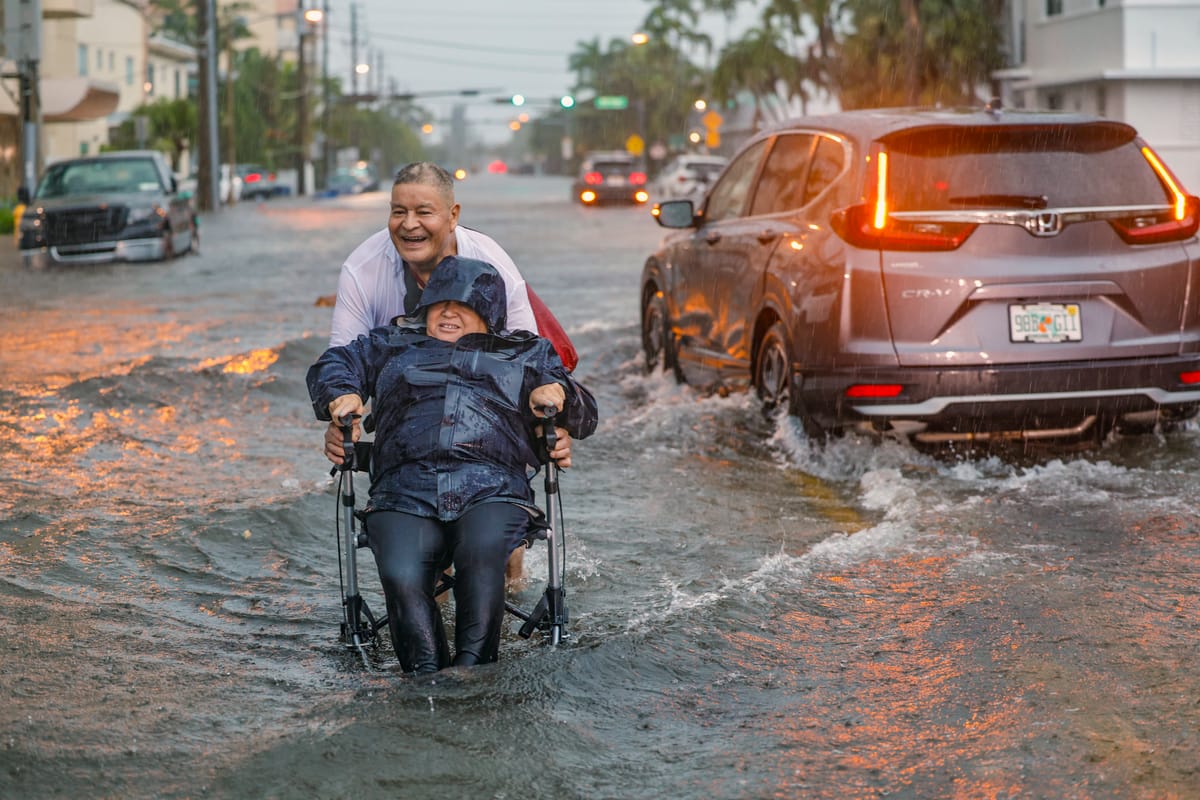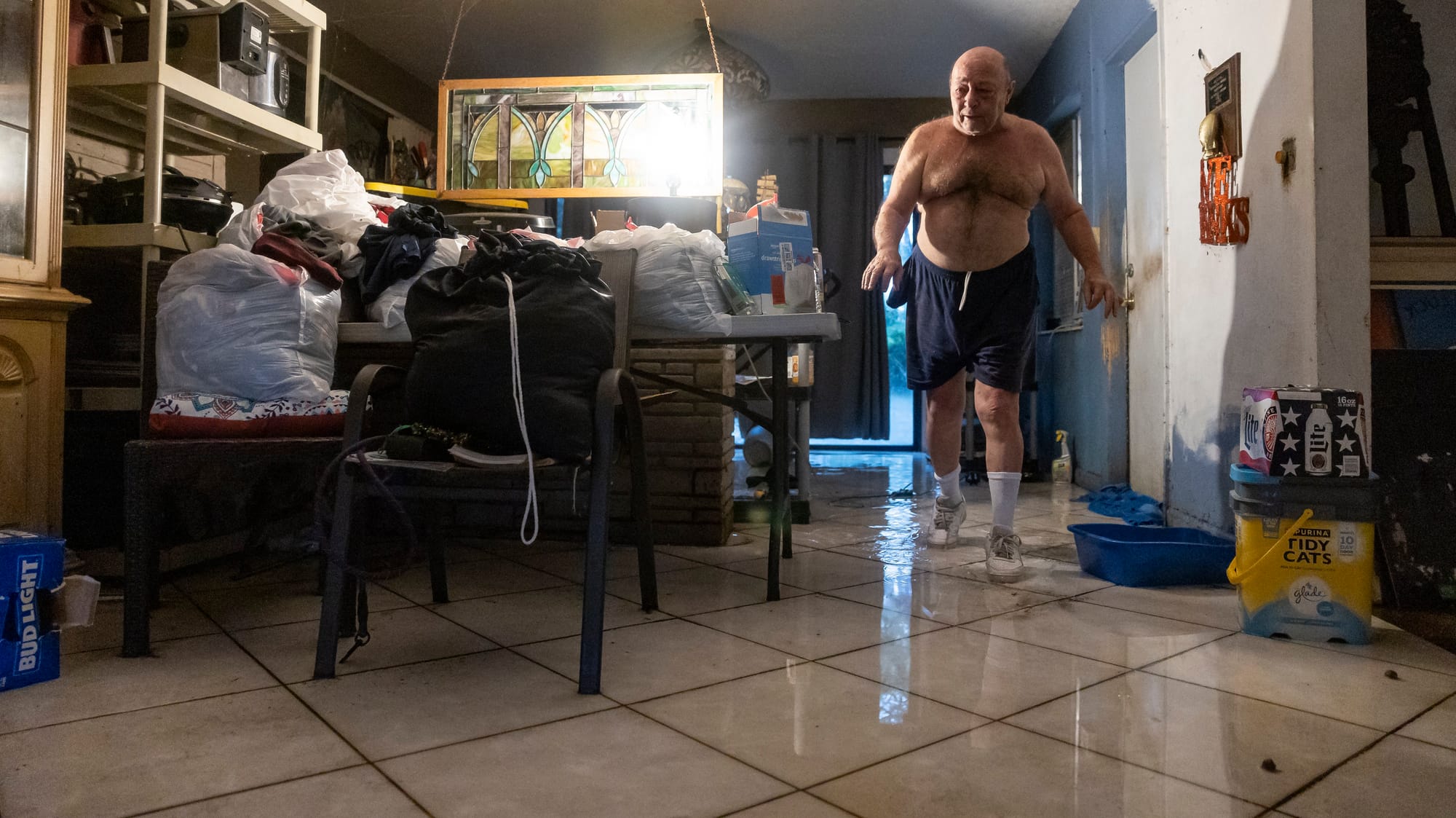Miami entering a state of unreality: Adaptation to climate change can’t fix the city’s water problems
As record rainfalls pound south Florida, Gov. Ron DeSantis decries ‘radical green zealots’ who want him to do more.

Published in The Atlantic
This story is not available for republication.
Hank Perez, 72, was trying to get home to North Miami Beach on Wednesday afternoon last week, but the rain had other plans. Floodwaters as high as the hood of Perez’s gray Toyota Yaris stalled the car; he pulled onto the median and called for roadside assistance, but it never came.
Thousands of other commuters found themselves in similar straits: About a foot and a half of water had fallen across south Florida — not the product of a hurricane or a tropical storm but of a rainstorm, dubbed Invest 90L, a deluge that meteorologists are calling a once-in-200-years event.
It was the fourth such massive rainfall to smite southeastern Florida in as many years.

“Rain bombs” such as Invest 90L are products of our hotter world; warmer air has more room between its molecules for moisture. That water is coming for greater Miami and the 6 million people who live here.
This glittering city was built on a drained swamp and sits atop porous limestone; as the sea keeps rising, the National Oceanic and Atmospheric Administration forecasts that south Florida could see almost 11 extra inches of ocean by 2040.
Sunny-day flooding, when high tides gurgle up and soak low-lying ground, have increased 400% since 1998, with a significant increase after 2006; a major hurricane strike with a significant storm surge could displace up to 1 million people. And with every passing year, the region’s infrastructure seems more ill-equipped to deal with these dangers, despite billions of dollars spent on adaptation.

Thirty years ago, when the dangers of climate change were beginning to be understood but had not yet arrived in force, the creeping catastrophe facing Miami might have been averted.
But as atmospheric concentrations of carbon reach levels not seen in 3 million years, politicians promise resilience while ignoring emissions; developers race to build a bounty of luxury condos, never mind the swiftly rising sea. Florida is entering a subtropical state of unreality in which these decisions don’t add up.
A massive network of canals keeps this region from reverting to a swamp, and sea-level rise is making operating them more challenging. The biggest canals, run by the South Florida Water Management District (SFWMD), offer primary drainage; smaller canals are operated by municipalities and private entities. The majority of these canals drain to the sea during low tides using gravity.
But sea-level rise erodes the system’s capacity to drain water — so much so that SFWMD has already identified several main canals that need to be augmented with pumps. The scary part about last week’s flood is that it didn’t happen during particularly high tides: Less rain, or rain that fell at a gentler rate, would have drained away easily.Other adaptation initiatives are underway. Miami is overhauling how it deals with stormwater and has installed pumps and backflow valves in vulnerable and low-lying neighborhoods. Miami Beach has spent about a decade raising roads, installing pumps and improving its infrastructure in a multimillion-dollar effort to buy time.

But the amount of rain that did fall last week is the sort of extreme-weather event that infrastructure planners don’t design for, if only because it would be too expensive to construct stormwater systems capable of moving that much water that quickly.
“Nowhere can withstand this much rain,” Bryan McNoldy, a senior researcher at the University of Miami’s Rosenstiel School of Marine, Atmospheric, and Earth Science, said. At his home in Biscayne Park, he slept uneasily after 9 inches of rain fell in just 11 hours. “That’s definitely more than what my area can ingest,” he said on Friday. Just a few more inches of rain would have meant water coming up through his floorboards.
The state government isn’t exactly ignoring the rising water. Gov. Ron DeSantis and his administration have attempted to address the havoc caused by the changing climate with his $1.8 billion Resilient Florida Program, an initiative to help communities adapt to sea-level rise and more intense flooding.
But the governor has also signed a bill into law that would make the term “climate change” largely verboten in state statutes. That same bill effectively boosted the use of methane, a powerful greenhouse gas, in Florida by reducing regulations on gas pipelines and increasing protections on gas stoves.
In a post on X the day he signed the bill, DeSantis called this “restoring sanity in our approach to energy and rejecting the agenda of the radical green zealots.”
Climate researchers, for their part, refer to this strategy as “agnostic adaptation” — attempting to deal with the negative effects of climate change while advancing policies that silence discussion or ignore climate change’s causes.
On Friday, at a press conference in Hollywood, Florida — which received more than 20 inches of rain — DeSantis repeated his message, emphasizing that “we don’t want our climate policy driven by climate ideology.”The Earth’s carbon cycle — which has not witnessed such a rapid increase in atmospheric carbon dioxide in the past 50,000 years — is without ideology. The carbon goes into the atmosphere, and everything that follows, follows.
In Miami, as the water levels rise, researchers predict that low-lying neighborhoods across the region will lose population. Eventually, Florida’s policies of agnostic adaptation will have to deal with this looming reality, where adaptation is clearly impossible, and retreat may be the only option left.


